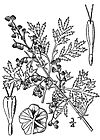Note: This is a project under development. The articles on this wiki are just being initiated and broadly incomplete. You can Help creating new pages.
Difference between revisions of "Artemisia argyi - Nagadaman, Mugwort"
(→Parts Used) |
(→Common names) |
||
| Line 15: | Line 15: | ||
==Common names== | ==Common names== | ||
| − | {{Common names|kn=|ml=|sa=|ta=|te=|hi=|en= | + | {{Common names|kn=Manjepatre, Urigattige|ml=Makkippuvu|sa=|ta=Makkippu|te=Masipatri|hi=Nagdona|en=Indian Wormwood, Fleabane}} |
==Habit== | ==Habit== | ||
Revision as of 16:50, 25 April 2018
Artemisia argyi, the Chinese mugwort, is a herbaceous perennial plant with a creeping rhizome. It is native to China, Korea, Mongolia, Japan, and the Russian Far East (Amur Oblast, Primorye). It is known in Chinese as àicǎo (艾草) or ài yè (艾叶) and in Japanese as gaiyou. It is used in herbal medicine for conditions of the liver, spleen and kidney.
Contents
Uses
febrifuge, styptic, sterility, uterus, dysmenorrhoea, coughs, Bacillus typhi, dysenteriae, coli
Parts Used
Chemical Composition
Extensive chemical studies of Artemisia species, including Chinese mugwort, document many compounds, including monoterpenes, sesquiterpenes, triterpenes and flavones.[1]
Common names
| Language | Common name |
|---|---|
| Kannada | Manjepatre, Urigattige |
| Hindi | Nagdona |
| Malayalam | Makkippuvu |
| Tamil | Makkippu |
| Telugu | Masipatri |
| Marathi | NA |
| Gujarathi | NA |
| Punjabi | NA |
| Kashmiri | NA |
| Sanskrit | |
| English | Indian Wormwood, Fleabane |
Habit
Identification
Leaf
| Kind | Shape | Feature |
|---|---|---|
| Simple | gracilis Pampanini | as such leaves are found throughout the range of the species, it does not seem worthwhile to formally separate them |
Flower
| Type | Size | Color and composition | Stamen | More information |
|---|---|---|---|---|
| Unisexual | 2-4cm long | Yellow | 5 | Flowers Season is June - August |
Fruit
| Type | Size | Mass | Appearance | Seeds | More information |
|---|---|---|---|---|---|
| simple | 5-10cm long | clearly grooved lengthwise, Lowest hooked hairs aligned towards crown | many | {{{6}}} |
Other features
List of Ayurvedic medicine in which the herb is used
- Vishatinduka Taila as root juice extract
Where to get the saplings
Mode of Propagation
How to plant/cultivate
We have very little information on this species and do not know if it will be hardy in Britain, though judging by its native range it could succeed outdoors in many parts of this country[3]
Commonly seen growing in areas
Waste places, roadsides, hills, steppe and forest.
Photo Gallery
References
External Links
- Pages that are stubs
- Ayurvedic Herbs known to be helpful to treat febrifuge
- Ayurvedic Herbs known to be helpful to treat styptic
- Ayurvedic Herbs known to be helpful to treat sterility
- Ayurvedic Herbs known to be helpful to treat uterus
- Ayurvedic Herbs known to be helpful to treat dysmenorrhoea
- Ayurvedic Herbs known to be helpful to treat coughs
- Ayurvedic Herbs known to be helpful to treat Bacillus typhi
- Ayurvedic Herbs known to be helpful to treat dysenteriae
- Ayurvedic Herbs known to be helpful to treat coli
- Herbs with Leaves used in medicine
- Herbs with common name in Kannada
- Herbs with common name in Hindi
- Herbs with common name in Malayalam
- Herbs with common name in Tamil
- Herbs with common name in Telugu
- Herbs with common name in English
- Habit - perennial plant
- Index of Plants which can be propagated by Seeds
- Herbs that are commonly seen in the region of Waste places
- Herbs that are commonly seen in the region of roadsides
- Herbs that are commonly seen in the region of hills
- Herbs that are commonly seen in the region of steppe and forest
- Herbs








